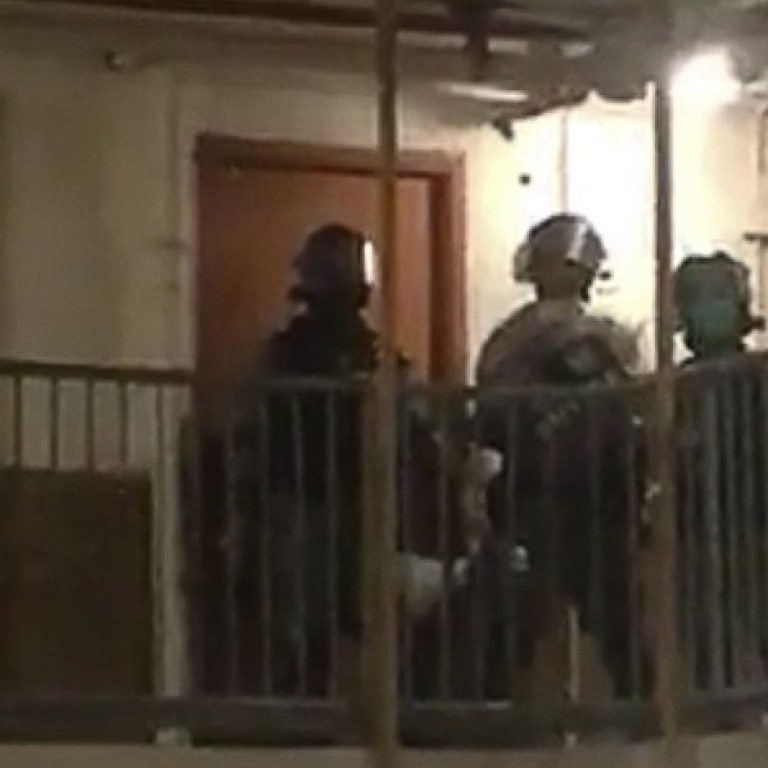
Hong Kong police arrest 17 people, seize 2.6 tonnes of chemicals in raids across city over series of bomb plots
- Suspects believed to be from the same group that planted explosives at Shenzhen Bay checkpoint and Caritas Medical Centre
- Officers raided 22 locations, including Tai Po, Yau Tong, Kwun Tong, and three flats in a commercial building on Bedford Road in Tai Kok Tsui
Police combed several areas in Hong Kong early on Sunday morning and arrested 17 people for their alleged involvement in three bomb plots earlier this year. Some 2.6 tonnes of chemicals and three unfinished home-made bombs were seized.
Officers from the organised crime and triad bureau raided 22 locations across the city – including in Tai Po, Yau Tong, Kwun Tong, and three flats in a commercial building on Bedford Road in Tai Kok Tsui – and found the three bombs, each containing 1.5kg of explosives, and three remote-controlled devices.
Some 2.6 tonnes of chemicals – including black powder, nitrate mixture, sulphur, magnesium powder, and sodium – were found in one of the flats in the building, along with six bottles of drain cleaner and 60 electric matches.
Senior Superintendent Steve Li Kwai-wah from the bureau said the bombs were meant to target members of the force. Police are tracing the source of the chemicals.
Unexploded IED found at Shenzhen border control point
Li said the arrested people – 12 men and five women, aged 21 to 53 – were working together over the three bomb plots in January and February, when an explosive device went off at Caritas Medical Centre in Cheung Sha Wan, a day before another explosive device was found at Shenzhen Bay control point.
Li said the items, especially the unfinished devices, could have exploded if heated or brought near a flame.

“All three cases involved explosives connected to remote-controlled devices and [suspects] would claim responsibility on a social media platform before or after the plots.
“Such a huge cache of chemicals and other related items stored in a commercial building would have put its residents under a tremendous threat. These people endangered public safety, ” Li said.
He refused to divulge further information about the suspects, and said police had yet to conduct tests to confirm the strength of the seized materials.
All the arrested belonged to a Telegram group called 92sign, which had probably led to the arrests, a legal source said. The backgrounds of the arrestees were not immediately clear, but it was understood that no student was involved.
Hospital bomb thought to be protest-linked, as message warns of ‘more to come’
In a Facebook post, Tai Po district councillor Herman Yiu Kwan-ho said a group of police officers, mostly in riot gear, raided a flat on the 21st floor of Kwong Lai House in Kwong Fuk Estate at about 2am on Sunday.
Officers later took a man away from the flat, while at least three people were also escorted from the public housing estate.
Councillors from two other districts also reported similar arrests in their communities.
Kwun Tong district councillor Wang Wai-lun said on Facebook that a young woman was arrested and detained at Kwun Tong Police Station.
Li criticised residents of Kwong Fuk Estate and the Tai Po district councillor for “obstructing police work” by creating disturbances, calling the fire service to the flat, and triggering a fire alarm that stalled elevators in the building.

On Telegram, the 92sign group had earlier claimed responsibility for the two bomb plots at the Shenzhen Bay checkpoint and Caritas Medical Centre.
“It’s too risky to stay in Hong Kong in the short run, so we’ve left before we can take revenge,” it said in a post on March 1. “But on the practical side, we need funding to keep running. Meals, ammunition, transport, and safety precautions, all these require money.”
As of March 8, it had received about HK$44,800 (US$5,800) from 29 donors.
Since late January, a series of bomb-related cases have taken place in Hong Kong. Beside the incidents at Caritas Medical Centre on January 27 and the Shenzhen Bay Control Point a day later, two explosive devices were found at Lo Wu railway station, near the mainland border, on February 2.
On February 5, a bomb scare forced the evacuation of Tai Po Market railway station and disrupted train services.
Officers from the bomb squad were called out, but the item – a shoebox wrapped with duct tape – proved to be empty.



